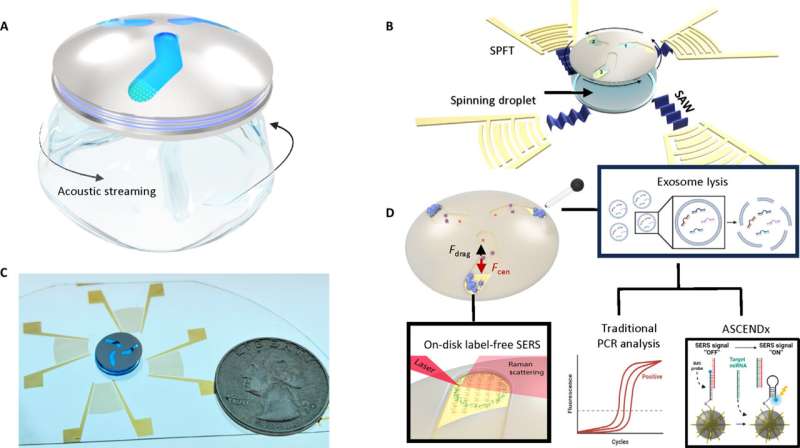This article has been reviewed according to Science X's editorial process and policies. Editors have highlighted the following attributes while ensuring the content's credibility:
fact-checked
trusted source
proofread
A water droplet spun by sound screens for colon cancer

Mechanical engineers at Duke University have devised a new type of diagnostic platform that uses sound waves to spin an individual drop of water up to 6,000 revolutions per minute. These speeds separate tiny biological particles within samples to enable new diagnostics based on exosomes.
A very light disc placed on top of the spinning drop features etched channels that are equipped with star-shaped nanoparticles tailored to enable the label-free detection of specific disease-relevant bioparticles called exosomes. The technique is much more efficient than current approaches, requiring less time and sample volume while inflicting less damage to the delicate exosomes.
Exosomes are released by cells and carry cell-specific cargos of proteins, lipids and genetic materials, and can be selectively taken up by other cells as a means of communication. Their specific makeup has shown potential for use for non-invasive diagnostics.
Compared to the bulky machines that cost upwards of $100,000 that currently isolate these biomarkers, the technique could allow new point-of-care applications ranging from precision bioassays to cancer diagnosis.
The research appears online March 8 in the journal Science Advances.
"The most common way to separate exosomes is ultrasound centrifugation, which takes at least eight hours, needs large sample sizes and often damages the exosomes," said Ty Naquin, a Ph.D. student working in the laboratory of Tony Jun Huang, the William Bevan Distinguished Professor of Mechanical Engineering and Materials Science at Duke. "Other methods all have their problems as well, such as having low purity or low yield. Our initial demonstrations seem to provide a path to a better solution."
The device centers on a drop of water placed within a ring of polydimethylsiloxane, a type of silicon commonly used in microfluidic technologies, which confines the water's boundaries and keeps it in place. The researchers then placed a sound wave generator on each side of the device and slanted them so that sound waves travel through the underlying platform to enter the droplet.
The sound wave generators create surface acoustic waves that push on the sides of the droplet like Donald Duck getting blown over by a gigantic pair of speakers. At high enough powers, the droplet stabilizes and spins around thousands of times per minute.
"We went up to 6000 RPMs in the paper, but beyond that the droplet begins leaning and runs the risk of spitting water out and getting crushed by the disc sitting on top," said Naquin.
The light disc placed on top features four channels etched into its surface. Rapid rotation causes exosomes to migrate to the ends of the channels while smaller proteins and other contaminants remain behind.
To detect the presence of specific biomarkers, the researchers turned to technology developed by Tuan Vo-Dinh, the R. Eugene and Susie E. Goodson Distinguished Professor of Biomedical Engineering and Professor of Chemistry at Duke.
His approach tethers DNA probes dubbed "inverse molecular sentinels" to the points of star-shaped gold nanoparticles. While these tethers naturally want to curl up on themselves, they are held straight by a segment of DNA that is tailored to bind with the target microRNA being tested for. When that microRNA comes by on its exosome carrier, it sticks to and removes the DNA, allowing the tether to curl and bring the label molecule in close contact with the nanostar.
When exposed to a laser, that label molecule emits a light called a Raman signal, which is generally very weak. But the shape and composition of the nanostars amplifies Raman signals several million-fold, making them easier to detect.
"Our platform detected biomarkers for colorectal cancer patients with results that strongly correlate with the gold standard for this type of diagnostic but with much less time and effort required," said Aidan Canning, a Ph.D. student working in the Vo-Dinh laboratory. "This is such a great marriage of two technologies."
While still in the early stages, Naquin and Canning are now thinking of new ways to wed these platforms with other advances for new types of investigations or commercialization.
"Our technology can discriminate between cancer and control groups with 95.8% sensitivity and 100% selectivity," said Huang. "Its potential is enormous in fundamental biological research and the early diagnosis and health monitoring of cancers, neurodegenerative and other diseases."
More information: Ty D. Naquin et al, Acoustic separation and concentration of exosomes for nucleotide detection: ASCENDx, Science Advances (2024). DOI: 10.1126/sciadv.adm8597

















